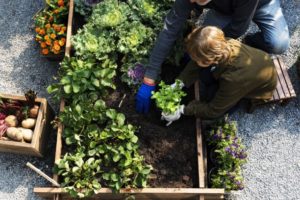
By: Megan Rasmussen MS, RDN
There are many reasons to grow your own garden. Growing your own produce can reduce your grocery bill. Home-grown produce often tastes much better than store-bought produce. You can even get some exercise, fresh air, and sunshine from spending all that time outdoors kneeling in the dirt. In addition to these personal benefits, growing your own vegetable garden is also good for the environment. Your carbon footprint is reduced when you grow your own food because it doesn’t have to travel to you from far away. Using produce from your own garden also doesn’t require extra plastic packaging.
With all these benefits in mind, you might be ready to start planting some seeds this spring. So here are a few important things to know before you start your garden.
Where should I plant?
One of the first things you must decide when starting a garden of your own is where to put it. A couple key considerations here are amount of sunlight and how close you are to a water source. Each plant has different needs for hours of sunlight but most plants need at least 6 hours of direct sunlight per day. So make sure there are no big trees surrounding your garden area. The next big consideration is water. Water is something your plants will need often so you want the process of watering to be as easy as possible. Make sure to plant your garden near a water source. That way it can easily be reached by a garden hose or sprinkler.
What should I plant?
One of the most obvious things you must know to start your own garden is what you will plant. Do you want to grow green leafy vegetables, fruits, or herbs? Maybe you want to grow absolutely everything! Just keep in mind, what you can grow will be limited by your geographical location. To find out what you can grow, first determine the plant hardiness zone you are living in by following this link. Once you know your zone, a quick Google search can tell you a few more important things:
- Which plants are best to grow in my zone?
- Which plants should be started indoors and which plants can be sown directly into the soil after the last frost?
- When does the last frost typically occur in my zone?
How often should I water?
As a general rule of thumb, most garden plants in the ground need an average of 1 inch of water per week. However, this doesn’t mean watering only once per week. It’s best to space out this inch of water over the course of the week. Watering 3 days per week can help do the trick. If you’re unsure if your garden needs water or not, don’t be afraid to get your hands dirty. Feel the soil and see if it sticks together or falls apart. If it is dry and barely stays together, that’s a sign you need to water.
What’s a weed and what’s the actual plant?
A dangerous mistake is to think any growth in your garden is good growth. Unfortunately, weeds are often easier to grow than legitimate garden plants. That’s why it’s important to be able to identify weeds vs. plants. Being able to identify the difference comes from experience and familiarity. To learn what common garden plants look like throughout the stages of growth, click here. For the most common weeds you might find in your garden, click here. When you stumble upon something unknown growing in your garden, use these references or utilize a plant-identifier app like Planta or PlantSnap.
What about compost, and fertilizer?
Both compost and fertilizer can provide essential nutrients to enrich the soil and help your plant thrive. However, it is important to use them properly to avoid upsetting the balance of the soil. Compost is a mixture of decayed organic material. It can be made from a mixture of food scraps, leaves, eggshells, coffee grounds, grasses, and other plant material. It is a natural and inexpensive way to enrich the soil. Fertilizer is a chemical or natural substance added to soil to increase its fertility. It comes in organic and inorganic forms. Organic forms, often made from manure, compost, or bone meal, feed and enrich soil. Inorganic fertilizers are used to promote rapid growth and can be damaging if used incorrectly. It is often recommended to use both compost and fertilizer for the best chances of having rich soil. For compost, add 1-2 inches per foot of loosened soil. For fertilizer, follow the instructions listed on the package to avoid providing too much or too little.
Growing a garden is not only a fun activity, but it can also provide you with delicious produce and decrease your ecological footprint. So now that you know the basics, what are you waiting for? Let’s get growing!
References:
- 10 Top Gardening Tips for Beginners. (2022). Retrieved 31 March 2022, from https://ift.tt/BOIGg60
- (2022). Retrieved 31 March 2022, from https://ift.tt/zW6aKVi
- (2022). Retrieved 31 March 2022, from https://ift.tt/r36YAab
- Compost vs. Fertilizer, Explained – Gardening Channel. (2022). Retrieved 31 March 2022, from https://ift.tt/hXTj9Ix
- Fratt, K. (2022). How to Identify the 27 Most Common Vegetable Plants. Retrieved 31 March 2022, from https://ift.tt/EjheuMW
- Grow your own vegetables to benefit your health and the environment. (2022). Retrieved 31 March 2022, from https://ift.tt/j0DEao6
- Home. (2022). Retrieved 31 March 2022, from https://ift.tt/OcHkDFq
"vegetable" - Google News
April 07, 2022 at 04:00PM
https://ift.tt/IljFTPr
World Health Day: Start your own vegetable garden - Kootenai Health
"vegetable" - Google News
https://ift.tt/SOE2meB
https://ift.tt/E7kAngb
Bagikan Berita Ini














0 Response to "World Health Day: Start your own vegetable garden - Kootenai Health"
Post a Comment